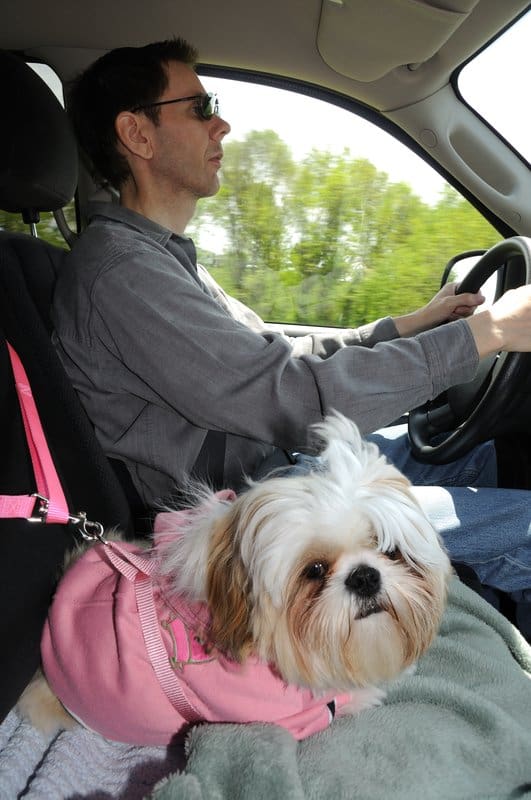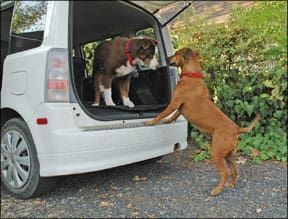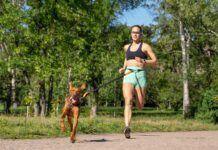Thinking of taking a road trip with your dog? Road trips can be a lot of fun and are a great way to see new and out-of-the-way parts of the country. Road trips with dogs bring unique challenges and require dog-specific prep but are a great way to spend time with your best friend. I just finished a coast-to-coast road trip with my three dogs (and three cats) to move from Brooklyn, New York, to Portland, Oregon. Our road trip took us a total of seven days, and the dogs were relaxed and having fun coast to coast! Here are a few tips and strategies for how to road trip safely with your dogs.
Car Safety for Dogs
If your dog isn’t used to spending time in the car, it’s a good idea to start slow with short rides to fun places in order to build up their comfort and familiarity with being in the car before embarking on longer road trips.
“The most important thing that pet parents can do for their dogs is keep them safe and secure while riding in a car. Purchase a ventilated pet carrier or crate for them to ride in. If you can’t find a crate or carrier to meet your needs, a pet safety belt or travel harness is the next best option” explained Jordan Holliday, Brand Marketing Specialist with Embrace Pet Insurance.
Because our SUV can’t hold crates for both my big dogs (100 pounds and 50 pounds), we use seat belts for both big dogs in the back seat which enable them to sit and lay down but keep them protected in the event of a car accident. If you’re going to use a canine seatbelt for your dog, be sure to research which ones are safest in crash testsand introduce the seat belt to your dog before the road trip so they are familiar with the sensation of being held in place.

On the road trip you will want to avoid ever leaving your dog in the car alone, as temperatures can climb very quickly even if you are just running into a store or restaurant. Traveling with another person is helpful when on a road trip with dogs so one person can stay with the dog(s) while the other goes into gas stations or restaurants for bathroom breaks and to get food.
Jordan Holliday also offered the reminder that you should “make sure your pet keeps his head inside the vehicle- Though your dog may enjoy the fresh air, it’s actually dangerous for him to stick his head out the window while you are driving. Oncoming traffic or flying objects could possibly injure him. It’s best for your dog to sit in a pet seat belt or crate, and not be roaming around the vehicle.”
How Frequently Should You Stop to Let Your Dog Stretch?
How often you need to stop will depend on the individual needs of your dog – young potty-training puppies and senior dogs may need more frequent stops. My sixteen-year-old dog and 21-month-old puppy needed bathroom breaks more frequently than my 7-year-old dog. In general, it’s a good idea to stop every couple of hours to let your dogs stretch their legs. These breaks are also a good opportunity for you to stretch, get a cup of coffee, or otherwise make sure you’re awake enough to continue driving.
When planning your road trip to include dogs, you’ll want to limit how may super long days you have in the car and divide your trip up with stops at pet-friendly hotels or with friends/family. With our cross-country road trip, we limited our driving to no more than seven hours a day (with the exception of the last day when the hotel we planned to stay at turned out to not be safe for the dogs) and we had to push on another few hours to our new house. For your road trip, be sure to plan your route before leaving and call ahead to reserve hotel rooms, and to confirm what individual hotel’s pet policies are. Many hotels have size, breed, or weight restrictions for dogs, and others limit the number of dogs you’re able to have in your hotel room.
Best Places to Stop on a Road Trip with Dogs
The best places to stop between destinations for potty breaks and stretching your dog’s legs tend to be state-run “rest stops” off the interstate. These rest stops have easy-to-access parking lots and usually have designated “pet areas” for walking and pottying dogs. Be sure to have plenty of poop bags for your journey (though some designated pet areas have those available). Some rest stops have small fenced dog runs, but be sure to keep your dog securely leashed – traffic, wildlife and large trucks can easily spook dogs.
If you have a pit-bull type dog or other breed/mix that is frequently discriminated against, be sure to research local laws for each city and state you will be driving through. You want to ensure that you aren’t unwittingly going to be in an area that has laws in place that ban or otherwise restrict certain breeds.
Dog Gear for Long Car Rides
Holliday suggests that dog owners should “bring something familiar for your pet- car rides can bring about anxiety in some dogs. To ease their mind and provide them with a sense of familiarity, bring their favorite blanket or toy along for the ride.”
It’s also important to bring water, portable water bowls, food, a pet first aid kit, any medications your dog regularly takes, proof of vaccinations/a health certificate from your veterinarian, up-to-date identification tags (on your dog), an extra leash, collar and/or harness. You’ll also want to bring a familiar dog bed or blanket if you’re going to be staying in a hotel as it will give your dog a place to settle in the room. Toys, safe bones or other chews, and treat-releasing toys can also help your dog settle into strange or stressful places.
How to Combat Motion Sickness in Dogs
Before embarking on a long road trip it’s a good idea to practice by taking your dog on short trips. This will help your dog adjust to car rides and lets you know if your dog is prone to motion sickness. If you find your dog doesn’t feel well on car rides it’s a good idea to talk with your veterinarian before your road trip. They may prescribe anti-nausea medication and will discuss feeding plans with you that may include adjusting meal time to avoiding feeding your dog right before you start driving for the day.
Sassafras Lowrey is an award-winning author and Certified Trick Dog Instructor. Sassafras lives and writes in Portland, Oregon with her partner, a senior Chihuahua mix, a rescued Cattle Dog mix, Newfoundland puppy, two bossy cats, and a formerly semi-feral kitten.







I have found those “pet areas” at rest stops are rife with goathead thorns! I end up walking my dogs on the grassy areas (and yes, picking up their poop) because walking in those thorny areas is painfully IMPOSSIBLE. These are rest areas in eastern Colorado, through Nebraska, into Iowa.